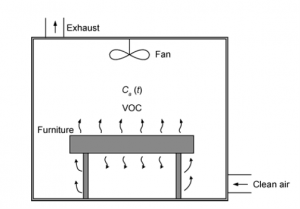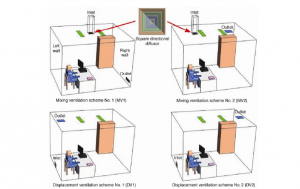Author: Weiser Simon
When I was backpacking in India, I spend some time in the big cities like Delhi and Bombay. One thing, that New Delhi is very famous for is the very high level of air pollution the city suffers from. At that time, I thought, I could never live my life at a place, where the exposure level was so high, that from time to time, I would have to worry about air pollutants or even wear a face mask when leaving the building (this was before Covid of course). You hear about high air pollution in the news, but no Austrian would ever think of being exposed to poor air quality in the alps for example. But you don’t have to be outside to be exposed to bad air quality, indoors can be even more harmful than outside! On average, we spend about 90% of our time inside which makes even small changes in quality very serious. The problematic indoors polluters aren’t big factories or cars though, most parts of the pollution can be traced to yourself, but also to the furniture in your apartment and office (Leamy, 2017).
Comparing an old handmade cabinet with a modern mass-produced one, you can easily tell, that there is less emphasis on high quality but rather on low production costs. Since the 1950s, the usage of particle wood has become an attractive alternative to planks of solid wood, because they are much cheaper (T. Salthammer, 2010). But those come with a price: These wood-based panels that are used in wardrobes, desks etc. emit Volatile Organic Compounds especially Formaldehyde, which can also be emitted by paint or glue. At room temperature, Formaldehyde is a highly reactive, flammable, and colourless gas, which has a very industrial or even pickle-like odor (Department of Health Minnesota, 2022). Since 2004 it is even considered carcinogenic and has been declared as an indoor pollutant of concern such as Benzene, Carbon monoxide and others. It can cause irritation of the eyes, throat, nose, but it can also have adverse health effects on your lungs leading to death. Therefore, it is regulated by the WHO and efforts are made to reduce the concentration in the production as much as possible.
But Formaldehyde is by far not the only harmful VOC that can be found in furniture. They can react on the surface of the wood panels with Ozone or OH radicals to generate thousands of complex products in the gas phase, which is one of the main topics of the indoor surface chemistry. Since inside, we have a bigger surface to volume ratio than outside, this problem rather occurs indoors. (Charles J. Weschler, 2018). To better regulate the emissions of all kinds of VOCs, certain certification labels were introduced in regions such as Europe, the US and China. The goal of such labels is to find out which pollutants should be targeted and to set a certain threshold which the pollutants must not exceed. The range of target pollutants extends from a few to over 100. The common testing method is to put the object in a an airtight chamber (Fig. 1) with constant temperature and humidity. The chamber needs to be supplied with fresh air with a constant air exchange rate. By measuring the outgoing air flow, the emission rate of the specimen can be calculated. (LIU WeiWei, 2012) . The problem is that in a realistic scenario, the air is not perfectly mixed and there are several other sources instead of just one.
Since the environment differs in every country with unique sets of weather conditions that are different all over the globe, it is impossible to form a universal labelling system. This lead to the point where sometimes even too many VOCs are targeted according to experts. There are several different labels out there like Blue Angel, Greenguard or the german AgBB, each with their own thresholds of Compounds and measuring techniques. (LIU WeiWei, 2012) (E. Uhde, 2006)

Figure 1: Testing Chamber
Let’s assume you have already furnished your flat the way you would like to but you experience bad air quality. One way for improvement could be to buy different furniture of course but this is not always an option. There are two other possible approaches: The first would be to implement a new or adjust the already existing ventilation system. The common systems follow either the displacement or a mixing ventilation scheme. But especially in offices, the workers have little to no influence on how the workplace is ventilated so they can resort to other means. Research shows, that the arrangement of furniture can have a great impact on the airflow field as well as on the temperature field and therefore on the distribution of pollutants within the room. In the Figure 3 you can see 3 different room arrangements (A, B and C) that were tested in a study and in Figure 4 the different ventilation schemes: There are two mixing ventilation (MV) systems, one with the outlet on the ceiling, the other one with the outlet on the lower end of the wall. The two displacement systems (DV) differ in that the outlet is once on the same and once on the other side as the inlet.

Figure 2: Results

Figure 3: Room layout

Figure 4: Ventilation systems
As you can see in the result in Figure 2, there is a notable difference between the best and the worst ventilation effectiveness without any changes in the ventilation just by rearranging the interior design. However, it would be too easy to claim, that the layout is the only factor: the geometry and ventilation must be considered as well! Always try to place the pollution source as far away from your usual breathing zone (like sitting at the desk) as possible and try to sit in the upflow field of the airflow. If building owners provide the schematics of their house’s ventilation to the renters, rearranging the furniture in such a way could greatly increase air quality and therefore the productivity and health of its inhabitants or workers (Ruining Zhuang, 2013).
So next time you are buying a new wardrobe, try to look out for certified labels! It could get more expensive, but your health is priceless!
Sources
Charles J. Weschler, N. C. (2018). Indoor Chemistry. Environmental Science and Technology, 10.
Department of Health Minnesota, U. (2022). Formaldehyde in Your Home. https://www.health.state.mn.us/communities/environment/air/toxins/formaldehyde.htm#:~:text=Formaldehyde%20is%20a%20colorless%20chemical,volatile%20organic%20compounds%20(VOCs).
Uhde, T. S. (2006). Impact of reaction products from building materials and furnishings on indoor air quality—A review of recent advances in indoor chemistry. Atmospheric Environment, 18.
Leamy, E. (2017, December 19). Your furnishings could be causing indoor air pollution. Washington Post; https://www.washingtonpost.com/lifestyle/home/your-furnishings-could-be-causing-indoor-air-pollution/2017/12/18/626ad808-d91c-11e7-b1a8-62589434a581_story.html.
LIU WeiWei, Z. Y. (2012). Indoor decorating and refurbishing materials and furniture volatile organic compounds emission labelling systems: A review. Chinese Science Bulletin, 11.
Ruining Zhuang, X. L. (2013). CFD study of the effects of furniture layout on indoor air quality under typical office ventilation schemes. 13.
Salthammer, A. S. (2010). Formaldehyde in the Indoor Environment. Chemical Reviews, 37.